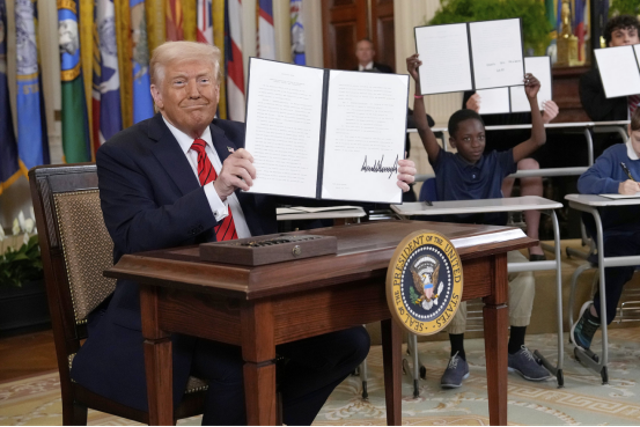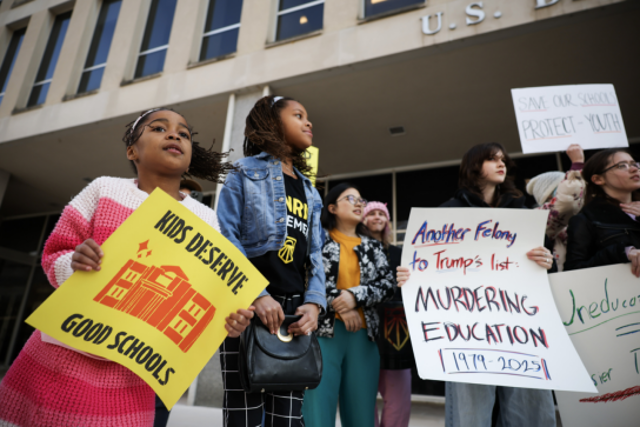On March 20, US President Donald Trump signed an executive order to dismantle the Department of Education. Accusing the agency of "breath-taking failures," the president vowed to return the money it controls to individual states.
Prior to this, the department had already disclosed plans to reduce its workforce by nearly 50%, a cut affecting all its operational divisions. Yet, the order begins a process that requires congressional approval. Many believe that Trump's efforts are likely to face court challenges and constitutional barriers.

President Donald Trump holds up a signed executive order in the East Room of the White House in Washington, Thursday, March 20, 2025. (Photo: cfp.cn)
What's the blame?
Founded in 1979 under President Jimmy Carter, the Department of Education was part of an effort to consolidate different education initiatives within the federal government. At its core, it administers student loans and runs programs to help low-income students. However, for years, many Republicans have argued that the department leaches power away from states and local school boards.
The department, in fact, has a limited mandate. It doesn't get to set curriculum or school programming. Instead, it focuses on collecting data on education, disseminating research, distributing federal aid, and enforcing anti-discrimination measures.
Bashing came from Trump, who said that "the US spends more money on education by far than any other country," yet he added that students rank near the bottom of the list.
Most children in the United States attend public schools, which are funded and managed by local authorities at no cost to families. One widespread misconception is that the federal Department of Education directly administers these schools or determines their curricula; but the truth is that this responsibility largely falls to individual states and local school districts.
The financial backbone of primary and secondary education comprises primarily state and local tax revenues, with federal contributions constituting a smaller fraction—approximately 13%—of the total funding.
A lifeline might fall in jeopardy
While the federal government contributes a modest portion of school funding, with states and local governments bearing the majority of the financial responsibility, its role in assisting high-need schools is disproportionately significant.

Protesters hold signs and chant during a rally in front of the Department of Education to protest budget cuts on March 13, 2025 in Washington, DC (Photo: cfp.cn)
To aid K-12 schools in low-income areas, Congress instituted Title I, allocating over $18.38 billion in the current fiscal year. This initiative, which has garnered broad bipartisan backing, benefits nearly 90% of U.S. school districts, ensuring critical support for educationally vulnerable institutions.
Some fear for programs like the Pell Grant, an initiative that offers financial aid to low-income students and services for students with disabilities. It could suffer as the department is falling apart. Critics like Democratic lawmaker Rashida Tlaib of Michigan argue that there is no other agency capable of enforcing national standards for equal education access.
"The Department's federal funding ensures that all children, regardless of who they are or which zip code they are born in, can achieve a quality education. Without the Department of Education, many of our kids will be left behind, unable to receive the education they need and deserve," she wrote. "Without the Department of Education, no one will be left to ensure civil rights laws are enforced in our schools."
An equal blow to international students
In addition to local students in the US, the dismantling might also cause a blow to those potential overseas students.
The U.S. Department of Education wields substantial authority in the allocation of educational funds, holding exclusive discretion over federal funding distribution to states and institutions. This includes determining whether funds are disbursed as subsidies or competitive grants, as well as specifying recipients and amounts at both the state and institutional levels.
Currently, U.S. public schools and universities receive approximately $76 billion annually in federal funding. Without the Department of Education, the allocation of these funds would become highly uncertain. Should states fail to bridge this financial gap, public universities might be compelled to raise tuition fees, reduce scholarship offerings, and even cut international student enrollment quotas.
Graduate programs, particularly at the doctoral and master's levels, heavily depend on research funding, such as STEM initiatives supported by federal agencies like the National Institutes of Health (NIH). A funding shortfall would lead to dramatic reductions in graduate admissions. Doctoral candidates would face intensified competition for scarce research assistant-ships (RA positions) and scholarships, disproportionately impacting international students who often rely on institutional funding.
This scarcity would directly exacerbate the financial burden on international students, pushing more applicants toward fully self-funded programs and driving up the overall cost of overseas study. Such a situation would create significant challenges for international students, such as diminished academic opportunities, heightened competition, and substantially increased educational expenses.
The absence of federal oversight could destabilize student visa processes. If the Department of Education ceased overseeing international student policies, visa approvals might become more unpredictable, potentially accompanied by divergent visa requirements across states.
To sum up, the elimination of the Department of Education would likely render U.S. graduate education more inaccessible to international students—characterized by intensified competition, elevated costs, and increased procedural uncertainties compared to current conditions.
Reporter: Guo Zedong
Editor: Yuan Zixiang, James, Shen He
















